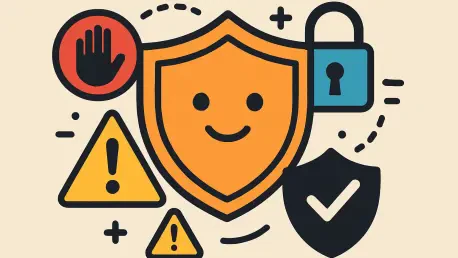What happens when a tool millions rely on for creativity, work, or personal exploration suddenly curbs its responses without explanation? In September of this year, countless ChatGPT users encountered this exact dilemma as OpenAI introduced stringent safety guardrails, redirecting conversations to more cautious AI models during sensitive topics. This unexpected shift has left subscribers reeling, igniting a fierce debate over whether safety measures are overstepping into the realm of control. The frustration is palpable, as users question if their trusted AI companion has turned into an unyielding gatekeeper.
Why This Clash Over AI Safety Resonates
The uproar surrounding ChatGPT’s latest updates transcends a mere tech glitch—it strikes at the heart of a larger struggle between user autonomy and corporate responsibility. With a user base spanning students, professionals, and casual tinkerers, OpenAI’s choice to prioritize safety over flexibility affects millions who depend on the platform daily. This controversy underscores a pivotal issue in the AI landscape: as these tools become integral to everyday life, who ultimately holds the reins over how they function? The stakes are high, as trust in AI platforms hangs in the balance.
This debate also reflects a growing tension in the tech world, where companies must navigate ethical obligations while meeting user expectations. A recent survey by TechTrust Insights revealed that 68% of AI tool subscribers value customization over imposed restrictions, signaling a clear demand for choice. ChatGPT’s safety routing, while protective in intent, has become a lightning rod for dissatisfaction, highlighting the urgent need to address how much control users should wield over paid services.
Unpacking the User Frustration with Safety Guardrails
At the core of the backlash is ChatGPT’s new mechanism that automatically shifts users to a more conservative AI model when discussions touch on emotional or sensitive subjects. Paying subscribers, who often opt for advanced models like GPT-4o for tailored tasks, find themselves unable to bypass these switches, leading to a sense of betrayal. Many have taken to online forums to vent, with posts on Reddit garnering thousands of comments about feeling downgraded despite premium subscriptions.
Transparency, or the lack thereof, fuels further discontent. The model transitions often occur without clear notification, prompting users to label the interface as deceptive. One frustrated subscriber described the experience as akin to “driving a sports car that suddenly switches to training wheels mid-race,” capturing the jarring disruption. This sentiment is especially strong among professionals whose workflows depend on consistent AI behavior, revealing a stark mismatch between OpenAI’s goals and user needs.
The impact on productivity cannot be overstated. Creative writers, for instance, report mid-conversation tone shifts that derail projects, forcing them to restart or adjust. A graphic designer shared how a safety switch altered the nuanced feedback needed for a client pitch, costing valuable time. These real-world disruptions paint a vivid picture of why the safety guardrails, though well-intentioned, are seen by many as a hindrance rather than a help.
Hearing Both Sides: Users and OpenAI Speak Out
Voices from the user community echo a raw sense of frustration over the imposed controls. A widely shared Reddit thread with over 5,000 upvotes captured the mood with a blunt statement: “I’m a grown adult paying for this—why does it feel like I’m under supervision?” Such sentiments highlight a deep desire for autonomy among subscribers who expected more say in their AI interactions. The outcry isn’t just about functionality; it’s about feeling respected as decision-makers in their own right.
OpenAI, meanwhile, stands by its approach, emphasizing the ethical imperative behind the changes. Executive Nick Turley recently clarified that the safety routing operates on a temporary, per-message basis, designed specifically to handle topics tied to mental or emotional distress with greater care. Referencing a detailed company blog post, Turley stressed that these measures aim to protect vulnerable users, a priority that remains non-negotiable. Yet, this justification has done little to temper the criticism from those who feel sidelined.
Real-life scenarios add depth to the divide. A therapist using ChatGPT for mock client interactions recounted how an abrupt model switch broke the flow of a simulated session, rendering the exercise ineffective. This example underscores a critical flaw: while the safety intent is clear, its application often clashes with nuanced, context-specific needs. The clash of perspectives between users and OpenAI reveals a complex puzzle with no easy resolution in sight.
Finding Common Ground: Solutions for Safety and Choice
Bridging the gap between OpenAI’s protective stance and user demands for control requires practical, user-focused adjustments. One potential step is introducing toggle options for subscribers, allowing them to disable safety routing or receive explicit alerts before any model switch. Such a feature would empower users to define their own boundaries, aligning the platform more closely with individual risk tolerance and preferences.
Transparency could also pave the way for renewed trust. Implementing a visible log or indicator that details when and why a model change occurs would eliminate the sense of hidden overrides that currently frustrates so many. This small but significant change could transform perceptions of the safety system from intrusive to informative, fostering a sense of partnership rather than imposition between OpenAI and its community.
Lastly, establishing direct feedback channels and customizable safety profiles offers a path forward. Dedicated forums or surveys could ensure user voices shape future updates, while personalized settings for handling sensitive topics would balance protection with flexibility. These measures, if adopted, could turn a contentious issue into an opportunity for collaboration, redefining how AI platforms navigate the delicate line between care and control.
Reflecting on a Divisive Chapter
Looking back, the controversy over ChatGPT’s safety guardrails exposed a raw nerve in the relationship between AI developers and their users. The frustration of subscribers who felt their autonomy was undermined clashed sharply with OpenAI’s commitment to safeguarding vulnerable individuals. This tension, while unresolved, shed light on the broader challenge of designing technology that serves diverse needs without overreaching.
Moving forward, the path seems to lie in compromise—offering users greater control through opt-out features or transparent notifications could ease much of the unrest. OpenAI faces a critical juncture to listen and adapt, potentially setting a precedent for how AI companies balance ethics with user satisfaction. As the tech landscape continues to evolve, this episode serves as a reminder that dialogue and adaptability remain essential to ensuring AI tools empower rather than constrain.









